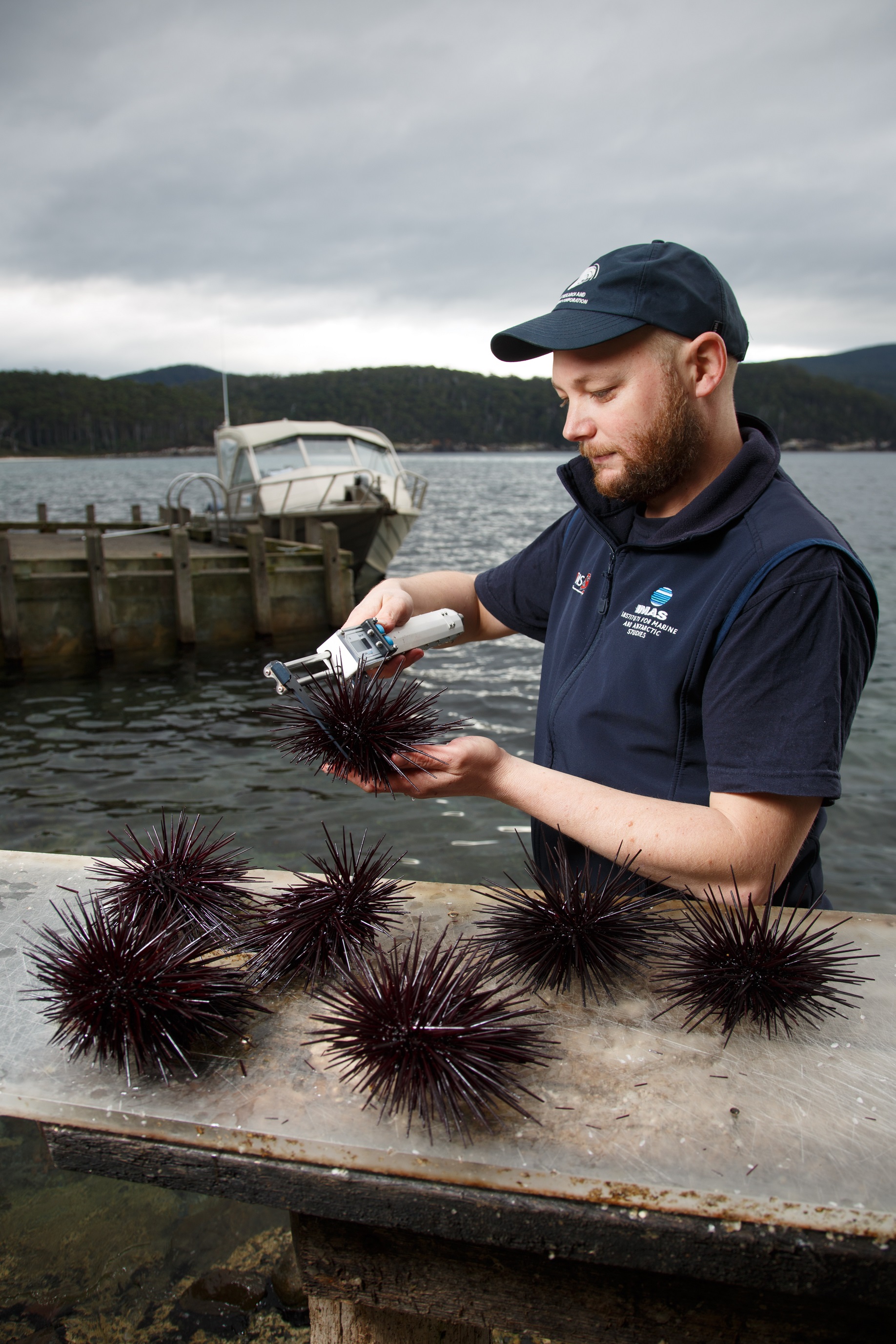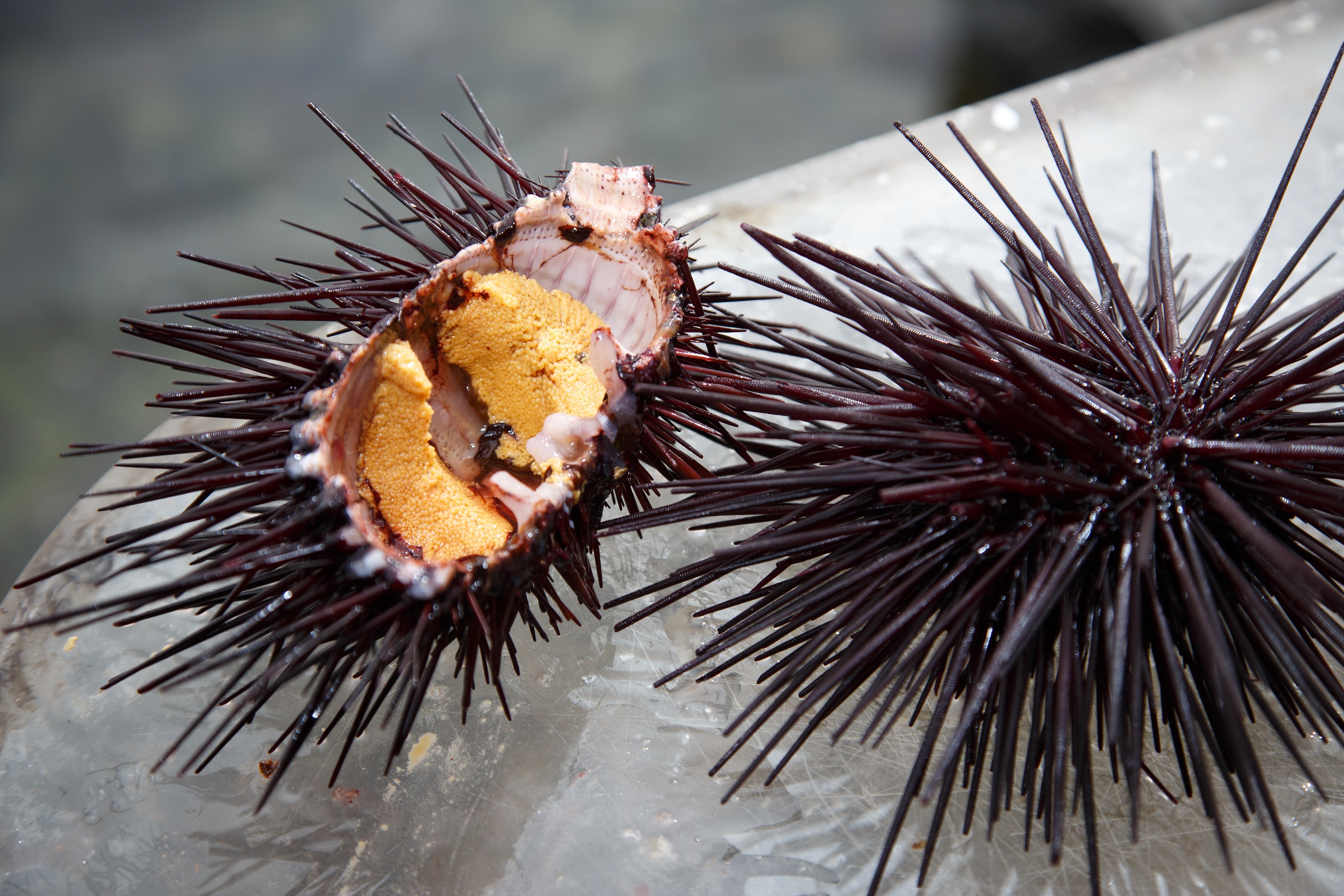Biology
The Longspined sea urchin is a large, fast growing Diadematidae that inhabits temperate reefs at varying depths up to 60m around southeast Australia, Norfolk and Lord Howe Islands, the Kermadec Islands and northern New Zealand (Schiel et al. 1986, Andrew 1993, Andrew and Byrne 2007, Pecorino et al. 2012, Perkins et al. 2015). In Australia, evidence suggests that the species arrived to the east coast of Tasmania via larval transport from spawning communities in coastal NSW and Victoria; it was first recorded in the northeast coast of Tasmania in 1978 (Edgar and Barrett 1997, Johnson et al. 2005, Ling 2008).
Longspined sea urchins have a pelagic larval stage of ~100 days (Huggett et al. 2005) meaning this species can travel long distances in ocean currents under the right conditions for their temperature limits (Ling et al. 2009b). Larvae have likely travelled to Tasmania through the poleward advance of the warm East Australia Current, which has extended further south with greater frequency over the past 60 years due to climate change (Ridgway
2007, Banks et al. 2010).

The species matures sexually at around 4 to 5 years old at a test diameter (TD) of 40-60mm, approaching a maximum TD of ~120mm (Ebert 1982) at ~25 to 35 years of age, after which, growth slows considerably (Ling et al. 2009a). The skeleton of a sea urchin is known as the “test”. The diameter of the test is measured using callipers placed between the spines to measure the diameter of the skeleton without the spines.
| Parameter | Meaning | Value |
|---|---|---|
| Test diameter at maturity | Size at which 50% of population becomes mature | 40 to 60 mm (King et al. 1994) (NSW) 60 to 70 mm (Andrew and Byrne 2007) (NSW) |
| Maximum test diameter | The asymptotic length at which growth in zero | 110 mm (Andrew and Byrne 2007) (NSW) 120 mm (Ebert 1982) (NSW) 126 mm (Pecorino et al. 2012) (New Zealand) 133 mm (Ling et al. 2009b) (TAS) |
| Lifespan | Time to reach 95% maximum test diameter | 20 years (Andrew and Byrne 2007) (NSW) 15 to 20 years (Pecorino et al. 2012) (New Zealand) 25 to 30 years (Ling et al. 2009b) (TAS) |
| Weight | Weight calculated from test diameter (TD) | Weight (g) = 0.0032*TD2.566 (data collected in May 2020 from Complete Harvest project, unpublished) |
Sea urchin gonads or “roe” have been consumed by some cultures for millennia and are now highly appreciated worldwide as a gourmet product comparable to caviar (Andrew et al. 2002, Sun and Chiang 2015, Lourenco et al. 2019). The profitability of a sea urchin fishery relies heavily on the marketable condition of the sea urchins’ roe, which can vary greatly between individuals depending on many factors (Blount and Worthington 2002, Blount et al. 2017). Gonad yield (as a percentage of body weight) and quality (judged by texture, colour, granularity and many other factors) are both affected by food availability, diet, season and individual movement, not just size and age (Lawrence et al. 1997, Lawrence et al. 2001, Andrew and Byrne 2007, Phillips et al. 2009, Phillips et al. 2010). Roe quality varies seasonally, with energy intake increasingly proportioned towards gonad development resulting in higher roe quality in the lead up to spawning, which for this species occurs around August (Ling et al. 2008). During and immediately following spawning, the roe/gonads are at low quality for the fishery, so the bulk of harvesting in Tasmania occurs between December and June (see below). The native Tasmanian short-spined sea urchin Heliocidaris erythrogramma has a complementary spawning season to the Longspined, meaning factories can continue processing sea urchins in Tasmania all year around.

Sea urchin populations, like other low-mobility resources, are spatially structured with aggregations occurring primarily because of habitat structure and food availability, making them highly patchy as a resource (Ouréns et al. 2015, Gutierrez et al. 2017). Longspined sea urchins have low mobility, homing strongly to available crevices, but do not show directional
movement towards food sources (Flukes et al. 2012) unlike other sea urchins, where directional movement towards available food results in mobile grazing fronts (Lauzon-Guay et al. 2006). Tracey et al. (2015) demonstrated this lack of directional movement in a culling experiment conducted in 2012 in Wineglass Bay Tasmania, showing that when plots were surveyed a year after targeted culling efforts, C. rodgersii densities had not increased. Because of this patchiness in stock, assessment methods should avoid the assumption of uniform distribution, and keep in mind that fishers will be concentrating their efforts in the higher density patches (Hernández-Flores et al. 2018, Casal et al. 2020).



